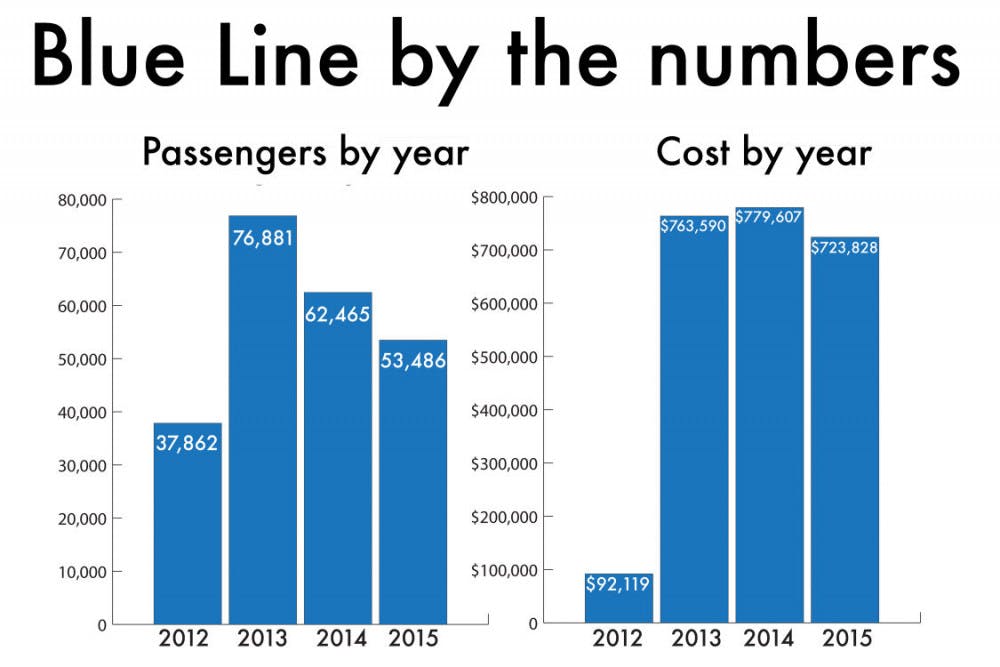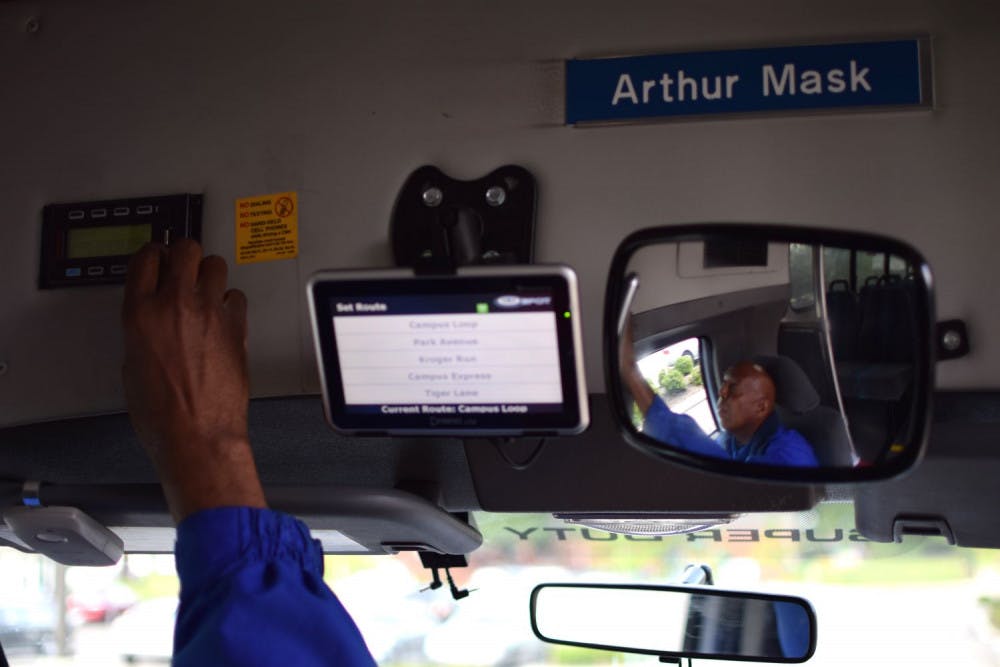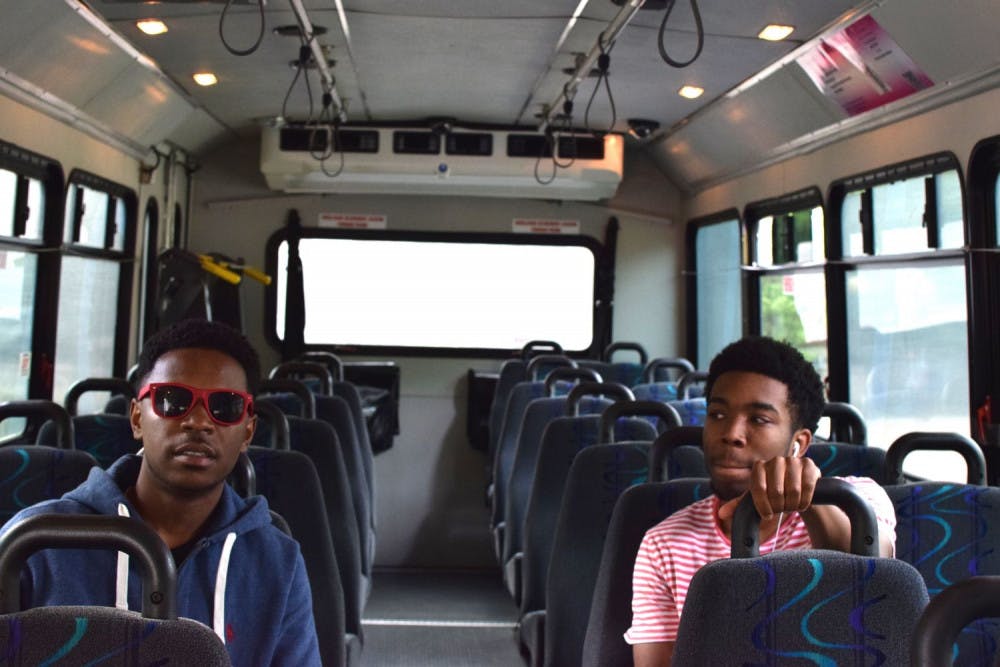
Sophomores Patrick Cephus (left) and Clentis Jennings (right) were two of three passengers on the Blue Line Tuesday afternoon. Cephus, a political science student, said that he does not use the bus line that often.
When Lori Ingram, a nursing student at the University of Memphis, boards the Blue Line bus service, a friendly driver and an empty shuttle usually greet her.Â
The 20-year-old student from South Korea rides the bus service three days a week to take her from the main campus to classes at the U of M’s Park Avenue campus, which would be a 30-minute walk. While the service is convenient for her, she has noticed how little it is used.
 “I feel like the only person on the bus almost all the time,†Ingram said. “Sometimes, I might see two or three other people on it.â€Â
A survey conducted by representatives from The Daily Helmsman came to a similar conclusion.
About 85 percent of the seats on the busses that traverse the campus area five days a week are empty, and some buses make a full round-trip completely empty.
Even though students and university employees can board the shuttles without paying a fare, the service is not free. The U of M paid nearly $725,000 in 2015 to Groome Transportation of Tennessee, the private company that operates the shuttles. That money comes from mandatory and non-mandatory parking fees students and university employee’s pay.Â
Since the University of Memphis signed the five-year contract with Groome in 2012, the U of M has paid more than $2.3 million to the company. The contract is set to end in February 2017.Â
While some on campus complain buses are almost always empty, the buses are essential to many people who work and live on campus, said Thomas Miller, assistant director of Parking and Transportation Services at the University of Memphis. Â
“The buses are really helpful. The city bus takes too long, and if I didn’t have the Blue Line, it would take me an hour to walk to work.†- Quita McKiney, 28, Physical Plant employee at the U of MÂ
“Yes, I’d love to see the buses with eight to 15 people on them at a time instead of threes and fours, but for those three and four, that’s their ride,†Miller said.Â
Miller said when he hears complaints about ridership, he explains the bus service gets thousands of people on it per week.Â
“It always surprises them,†Miller said.Â
The university reported 62,465 riders in the fiscal year 2014-15, according to information provided to The Daily Helmsman by Miller. (These numbers do not include special events or the trips to and from Tiger games.)

LEFT: This is how many people ride the Blue Line buses per year. These numbers do not include special events or round trips to Tiger games. These numbers were provided by the U of M's Parking and Transportation Services. The counts are made through cameras inside the buses that were installed through a third-party company, not Groome Transportation of Tennessee.
RIGHT: This is how much money the University of Memphis pays Groome to run the Blue Line system. The funds that pay for this come from the mandatory and non-mandatory parking fees. With the exception of 2012, the university pays Groome about 20 percent of the parking revenue. Data collected from the University of Memphis Parking and Transportations Services to the Daily Helmsman via an open records request.
Using the data from the Helmsman survey and determining the total number of hours and days the buses are in service, an analysis estimated the Blue Line service has about 2,300 riders every week – which is very close to the numbers Miller provided and further confirms that many buses are driving around mostly empty. Â
Miller’s ridership numbers are collected via a camera mounted on the buses through a third party company, not Groome. The university only pays Groome for the hours they drive.Â
“At the end of each month we go over the performance and adherence to the number of buses and time on route and if there are shortfalls we do not pay for these lost hours,†Miller said. “We have had a terrific relationship with Groome, they are a family owned company and while they have many clients nationwide, airports and universities, they are not one of those parking conglomerates. It is a good fit between the U of M and Groome.â€

Arthur Mask drives students around campus every Tuesday from noon to 6 p.m. on the University of Memphis’ shuttle system, the Blue Line. On his final trip Tuesday afternoon, only three students were using the bus.
 Many of those who live in the graduate student housing at Park Avenue do not have cars or share one with a family member, Miller said. The Blue Line is their only way to get to the main campus. Â
Many U of M employees without cars rely on the Blue Line as well, he said.
Workers such as Quita McKiney, 28, said the shuttle takes her to work.Â
 “The buses are really helpful,†she said. “The city bus takes too long, and if I didn’t have the Blue Line, it would take me an hour to walk to work.â€
Larry Winters, a Blue Line shuttle driver, said he sees about 40 passengers a day during his 11-hour shift. Winters was a supervisor for the Memphis Area Transit Authority, where he worked for 30 years, before he took this job.Â
Winters does not see as many passengers as when he drove a city bus, he said, but he does get to know the passengers a lot better, many of whom are U of M Physical Plant employees who rely on the Blue Line to get to work.Â
“I drop a lot of them off at South campus around 3 (p.m.)†Winters said. “That’s when most of them start work.â€
The Helmsman’s surveyors recorded bus ridership for a three-week period before spring break, riding the shuttles for a little more than 12 hours. They rode the bus during all hours of the day and every day of the week looking specifically at the two main campus routes, the Park Avenue route and the special route to the Kroger at Poplar Plaza.
During the 26 round trips, the survey showed that 106 people took the bus. Two of the round trips had no riders at all, and 21 of the rides had six or fewer riders. The most popular route was the Thursday afternoon route to Kroger, which had between 14 to 16 riders at a time.
Each of the buses had 28 seats for riders, which means of the 26 round trips, there were a total of 728 seats. Of those 728 seats, 106 were filled for at least part of the trip with a rider. The remaining 622 seats were empty for the entire trip, which is about 85 percent.




